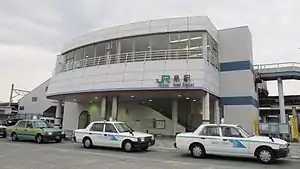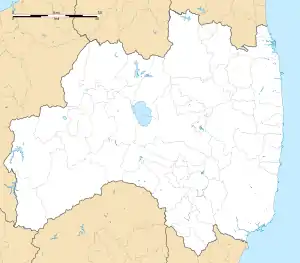Izumi Station (Iwaki)
Izumi Station (泉駅, Izumi eki) is a railway station on the Jōban Line in the city of Iwaki, Fukushima, Japan, operated by East Japan Railway Company (JR East). The station also has a freight depot for the Fukushima Rinkai Railway Main Line.
Izumi Station 泉駅 | |||||||||||||||
|---|---|---|---|---|---|---|---|---|---|---|---|---|---|---|---|
 Izumi Station in December 2013 | |||||||||||||||
| General information | |||||||||||||||
| Location | Izumi-machi, Iwaki-shi, Fukushima-ken 971-8185 Japan | ||||||||||||||
| Coordinates | 36°57′20″N 140°51′15″E | ||||||||||||||
| Operated by | |||||||||||||||
| Line(s) | ■ Jōban Line | ||||||||||||||
| Distance | 195.0 km from Nippori | ||||||||||||||
| Platforms | 1 side + 1 island platform | ||||||||||||||
| Tracks | 3 | ||||||||||||||
| Other information | |||||||||||||||
| Status | Staffed (Midori no Madoguchi ) | ||||||||||||||
| Website | Official website | ||||||||||||||
| History | |||||||||||||||
| Opened | 25 February 1897 | ||||||||||||||
| Passengers | |||||||||||||||
| FY2018 | 2449 daily | ||||||||||||||
| Services | |||||||||||||||
| |||||||||||||||
| Location | |||||||||||||||
 Izumi Station Location within Fukushima Prefecture  Izumi Station Izumi Station (Japan) | |||||||||||||||
Lines
Izumi Station is served by the Jōban Line, and is located 195.0 km from the official starting point of the line at Nippori
Station layout
Izumi Station has one island platform and one side platform connected to the station building by a footbridge. The station has a Midori no Madoguchi staffed ticket office.
Platforms
| 1 | ■ Joban Line | for Takahagi, Hitachi, Katsuta, Mito, Tomobe, Ishioka and Tsuchiura |
| ■ Jōban Line (Limited Express) | for Takahagi, Mito, Tsuchiura, Ueno, Tokyo and Shinagawa | |
| 2,3 | ■ Jōban Line | for Iwaki, Hirono, Tomioka, Namie, Haranomachi, Soma and Sendai |
| ■ Jōban Line (Limited Express) | for Iwaki and Sendai |
History
Izumi Station opened on 25 February 1897.[1] The station was absorbed into the JR East network upon the privatization of the Japanese National Railways (JNR) on 1 April 1987.[1]
Passenger statistics
In fiscal 2018, the station was used by an average of 2449 passengers daily (boarding passengers only).[2]
Surrounding area
- Iwaki-Izumi Post Office
- Onahama Port
- Aquamarine Fukushima
See also
References
- Ishino, Tetsu, ed. (1998). 停車場変遷大辞典 国鉄・JR編 [Station Transition Directory - JNR/JR]. Vol. II. Japan: JTB. p. 433. ISBN 4-533-02980-9.
- 各駅の乗車人員 (2018年度) [Station passenger figures (Fiscal 2018)] (in Japanese). Japan: East Japan Railway Company. 2019. Retrieved 11 April 2020.
External links
- Official website (in Japanese)